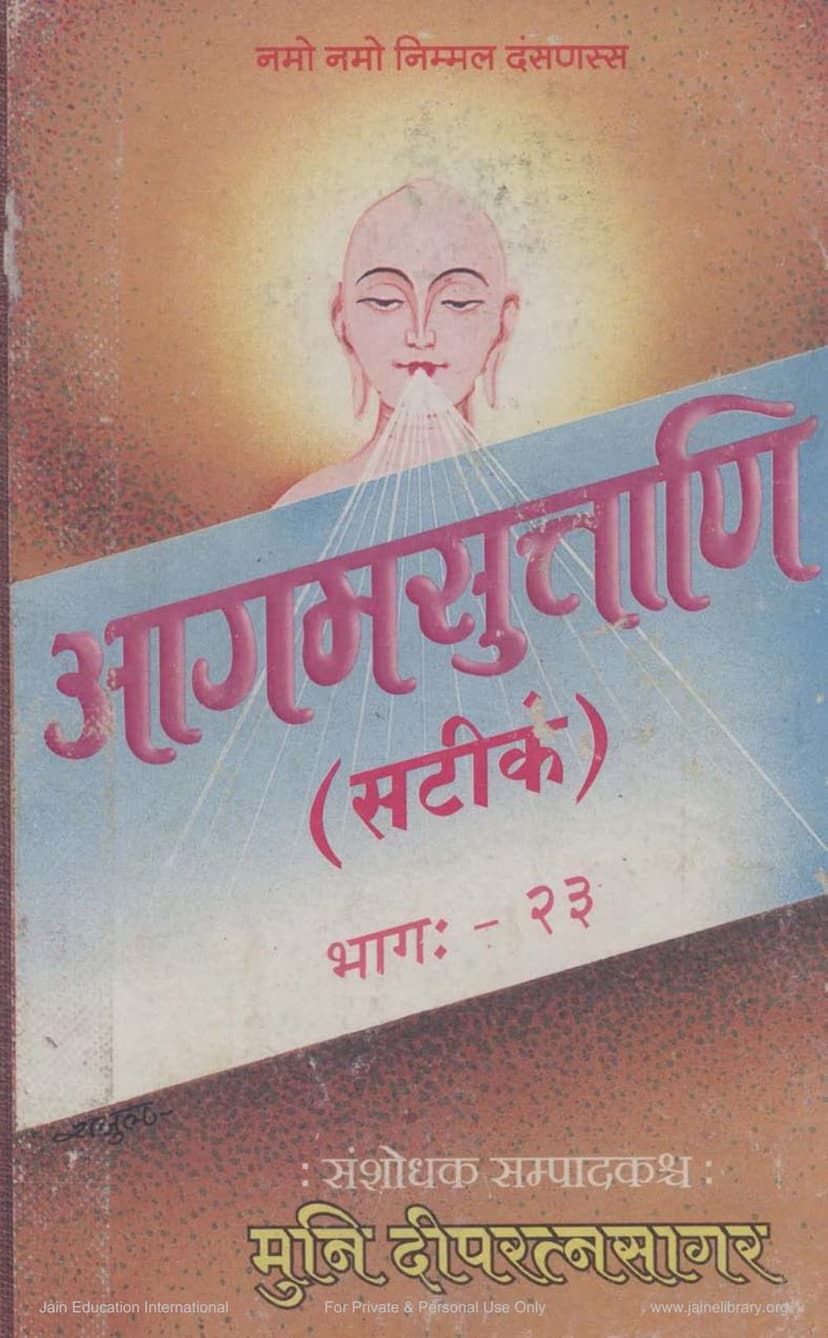Agam Sutra Satik 37 Dasashrutskandh ChhedSutra 4
Added to library: September 1, 2025

Summary
Based on the provided text, here's a comprehensive summary of the Jain text "Agam Sutra Satik 37 Dasashrutskandh ChhedSutra 4":
Book Title: Agam Sutra Satik 37 Dasashrutskandh ChhedSutra 4 Author(s): Dipratnasagar, Deepratnasagar Publisher: Agam Shrut Prakashan Catalog Link: https://jainqq.org/explore/003373/1
This document is part of a larger series titled "Agam Suvani (Satik)", specifically Volume 23, which focuses on Jain Agamic texts with commentaries. The title indicates that this particular volume contains:
- Dashaśrutaskandha-ChhedaSūtra: The primary text being summarized here, identified as the fourth ChhedaSutra in this section.
- Jita-Kalpa-ChhedaSūtra: Another ChhedaSutra.
- Mahānishītha-ChhedaSūtra: A third ChhedaSutra.
The content is presented in Gujarati and Hindi, with the main textual analysis in Gujarati and the commentaries and explanations likely in Gujarati as well. The title "Satik" implies that the text includes a commentary (Tikā). The preface and table of contents (Vishayanukram) provided give a clear outline of the content.
Key Contents and Structure (based on the Table of Contents and initial pages):
The book is structured into three main ChhedaSūtras:
I. Dashaśrutaskandha-ChhedaSūtra (Pages 1-238 approx.) This section appears to be the most extensive and covers a wide range of topics related to conduct, spiritual states, and monastic discipline. Based on the table of contents, it includes discussions on:
- Asamādhi Sthāna (असमाधि स्थानं): Places or states of disunity/lack of peace.
- Shabala Dashā (शबलदशा): Mixed or impure states.
- Upaashak Pratima (उपाशक प्रतिमा): Vows and stages of observance for lay followers (Upāsaka).
- Bhikshu Pratima (भिक्षु प्रतिमा): Stages and conduct for monks (Bhikshu).
- Paryushana (पर्युषणा): The annual period of fasting and repentance.
- Mohanīya Sthāna (मोहनिय स्थान): States related to the deluding karma.
- Nidāna-ādi (निदान-आदि): Vows made with the intention of future rewards and related topics.
- Āshatanām (आशातनाम्): Reverential disrespect or offenses.
- Gaṇi Sampadā (गणिसम्पदा): Qualities and accomplishments of a monastic leader or scholar (Gaṇi).
- Chitta Samādhistāna (चित्त समाधिस्थानं): States of mental peace and concentration.
II. Jita-Kalpa-ChhedaSūtra (Pages 91-120 approx.) This ChhedaSutra focuses on aspects of discipline and penance, including:
- Ālokana Prayaśchitta (आलोचना प्रायश्चित्त): Confession as penance.
- Pratikramaṇa Prayaśchitta (प्रतिक्रमण प्रायश्चित्त): Repentance and backtracking from errors as penance.
- Tadubhaya Prayaśchitta (तदुभय प्रायश्चित्त): Penance involving both the above.
- Viveka Āha Prayaśchitta (विवकाह प्रायश्चित्त): Penance related to discrimination or discernment.
- Kāyotsarga Prayaśchitta ( कायोत्सर्ग प्रायश्चित्त): Penance through body-abandonment or meditation.
- Tapa Prayaśchitta (तप प्रायश्चित्त): Penance through austerity.
- Pratisēvanā (प्रति सेवना): Serving or ministering to others.
- Chhēda-Prayaśchitta (छेद-प्रायश्चित्त): Penance involving expulsion or cutting off.
- Mūla Prayaśchitta (मूल प्रायश्चित्त): Fundamental penance.
- Pārāśchitta Prayaśchitta (पाराश्चित प्रायश्चित्त): Penance for serious transgressions.
- Upasaṃhāra (उपसंहार): Conclusion.
III. Mahānishītha-ChhedaSūtra (Pages 125-238 approx.) This ChhedaSutra deals with more profound and potentially severe aspects of monastic life and practice:
- Shalya Uddharaṇaṁ (शल्यउद्धरणं): Removal of inner impurities or obstacles (like thorns).
- Karma Vivāda (कर्मविवाद): Disputes or discussions about karma.
- Kula Lakṣaṇaṁ (कुल-लक्षणं): Characteristics of a lineage or community.
- Kuśīla Saṁsarga (कुशील-संसर्ग): Association with those who have fallen from strict principles.
- Navanata Sāraṁ (नवनत-सारं): Essence of new or renewed conduct.
- Gītārtha Vihāraṁ (गीतार्थविहारं): Conduct of those who understand the meaning of scriptures.
- Ēkānta Nirjarā (एकांतनिर्जरा): Solitary or exclusive shedding of karma.
- Suṣaḍha Aṉagārakathā (सुषढ अनगारकथा): Stories of certain virtuous ascetics.
Commentary and Editorship: The primary editor and compiler is Muni Deepratnasagar, who is also credited with revising and editing the work. The publication is by Agam Shrut Prakashan. The date mentioned (April 14, Dīpavali 2056 Vikram Samvat, i.e., April 14, 2000) indicates the publication timeline.
Key Themes and Purpose: The book aims to provide a detailed understanding of Jain monastic code, ethical guidelines, and spiritual practices through the lens of the ChhedaSūtras and their commentaries. It covers the conduct of both monks and lay followers, outlining stages of spiritual progress, permissible and impermissible actions, penances, and the consequences of actions, particularly in relation to the concept of karma and the path to liberation. The detailed breakdown of each ChhedaSūtra suggests a comprehensive manual for understanding and practicing Jain principles.
Overall: This is a scholarly and detailed presentation of core Jain ethical and disciplinary texts, essential for understanding the practical aspects of the Jain monastic tradition and lay observance. The inclusion of commentaries by Muni Deepratnasagar suggests a modern interpretation and clarification of these ancient texts.